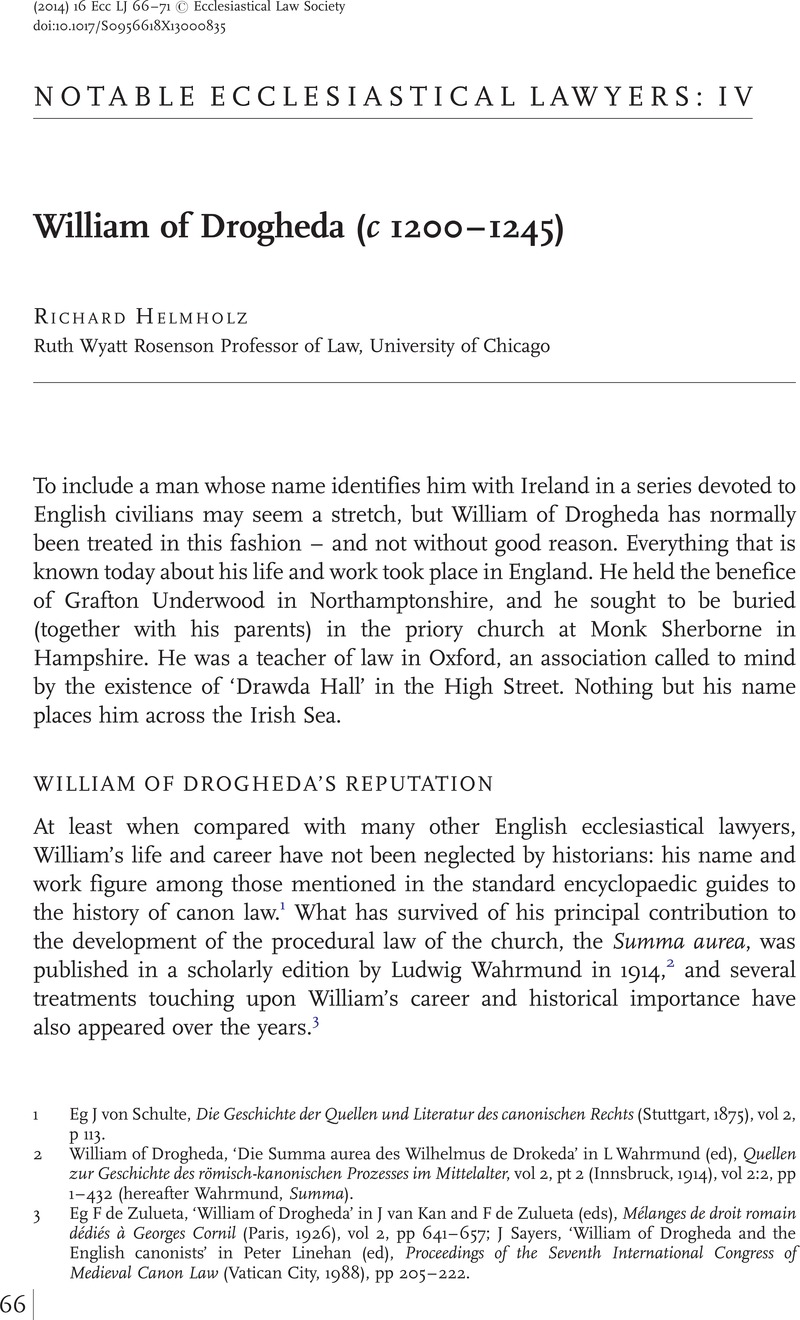Article contents
William of Drogheda (c 1200–1245)
Published online by Cambridge University Press: 13 December 2013
Abstract

- Type
- Notable Ecclesiastical Lawyers: IV
- Information
- Copyright
- Copyright © Ecclesiastical Law Society 2014
References
1 Eg von Schulte, J, Die Geschichte der Quellen und Literatur des canonischen Rechts (Stuttgart, 1875), vol 2, p 113Google Scholar.
2 William of Drogheda, ‘Die Summa aurea des Wilhelmus de Drokeda’ in Wahrmund, L (ed), Quellen zur Geschichte des römisch-kanonischen Prozesses im Mittelalter, vol 2, pt 2 (Innsbruck, 1914), vol 2:2, pp 1–432Google Scholar (hereafter Wahrmund, Summa).
3 Eg de Zulueta, F, ‘William of Drogheda’ in van Kan, J and de Zulueta, F (eds), Mélanges de droit romain dédiés à Georges Cornil (Paris, 1926), vol 2, pp 641–657Google Scholar; Sayers, J, ‘William of Drogheda and the English canonists’ in Linehan, Peter (ed), Proceedings of the Seventh International Congress of Medieval Canon Law (Vatican City, 1988), pp 205–222Google Scholar.
4 Maitland, F, ‘William of Drogheda and the universal ordinary’ in Canon Law in the Church of England (London, 1898), pp 107–116Google Scholar.
5 Richardson, H, ‘Azo, Drogheda, and Bracton’, (1944) 59 English Historical Review 22–47CrossRefGoogle Scholar. See also Kantorowicz, H, Bractonian Problems (Glasgow, 1941), pp 27–36Google Scholar.
6 Sayers, J, Papal Judges Delegate in the Province of Canterbury, 1198–1254 (Oxford, 1971), pp 54, 71, 109, 222, 232–233Google Scholar.
7 Kantorowicz, Bractonian Problems, p 29.
8 M Bethmann-Hollweg (1795–1877), Der Civilprozeß des gemeinen Rechts in geschichtlicher Entwicklung (Bonn, 1864–1874), vol 6, p 126: ‘Von der Schrift selbst ist nicht viel Gutes zu sagen’.
9 Maitland, ‘William of Drogheda’, p 110.
10 See Andreae, Joannes, Proemium to Willelmus Durantis, Speculum iudiciale (Basle, 1574)Google Scholar, sv plurimis [p 4 circa medium]: ‘Secundum sit Gulielmus de Droreda [sic] Anglicus qui legens Oxoniae satis commendabilem et copiosum libellum composuit de iudiciorum ordine’.
11 See his Laudes academiae Perusinae et Oxoniensis (Hanover, 1605), cited in Maitland, ‘William of Drogheda’, p 108, n 2.
12 See Worcester Cathedral Library, MS F 74, fols 75–170.
13 See J Sayers, ‘William of Drogheda’ in Oxford Dictionary of National Biography.
14 See Wahrmund, Summa, pp ix–xi.
15 See Norr, K, Romanisch-kanonisches Prozessrecht (Heidelberg, 2012)CrossRefGoogle Scholar; Fowler-Magerl, L, Ordines iudiciarii and Libelli de ordine iudiciorum (Turnhout, 1994)Google Scholar; Mausen, Y, Veritatis adiutor: la procédure du témoignage dans le droit savant et la pratique française (XIIe–XIVe siècles) (Milan, 2006)Google Scholar.
16 With characteristic modesty, he gave his paper the title ‘William of Drogheda: a few notes’. I thank Professor Lindner for his generosity in sharing it with me.
17 Wahrmund, Summa, Proem (pp 6–7).
18 Ibid, title 28, a reference to the glossa ordinaria of Bernard of Parma; see also Sayers, Papal Judges Delegate.
19 He was described as ‘primarily a legist’ in de Zulueta, ‘William of Drogheda’, p 655.
20 See Waelkens, L, ‘Medieval family and marriage law: from actions of status to legal doctrine’ in Cairns, J and du Plessis, P (eds), The Creation of the Ius Commune: from casus to regula (Edinburgh, 2010), pp 103–125Google Scholar.
21 Stein, P, Roman Law in European History (Cambridge, 1999), pp 57–59CrossRefGoogle Scholar.
22 Tardif, A, La procédure civile et criminelle aux XIIIe et XIVe siècles (Paris, 1885), pp 1–4Google Scholar; Lévy, J, Le problème de la preuve dans les droits savants du Moyen Age (Brussels, 1965), pp 137–167Google Scholar.
23 Most particularly by the enactment by the Fourth Lateran Council (1215) of the constitution Quoniam contra falsam (X 2.19.11).
24 Eg de Zulueta, ‘William of Drogheda’, p 646.
25 Wahrmund, Summa, titles 99–141.
26 Ibid, title 245.
27 See Wetzstein, T, ‘Prozeßschriftgut im Mittelalter: einfürende Überlegungen’ in Lepsius, S and Wetzstein, T (eds), Als die Welt in die Akten kam: Prozeßschriftgut im europäischen Mittelalter (Frankfurt, 2008), pp 1–27Google Scholar.
28 See his ‘Ordo iudiciarius’ in Bermann, F (ed), Libri de iudiciorum ordine (Göttingen, 1842, reprinted 1965), pp 89–316Google Scholar.
29 Eg Wahrmund, Summa, title 64, dealing with the multiplication of legal actions based on a single wrong.
30 Ibid, title 95.
31 Cod 2.13.15.
32 Wahrmund, Summa, title 65.
33 Lyndwood, W, Provinciale (seu Constitutiones Angliae) (Oxford, 1679), p 314Google Scholar, sv perjurio.
34 Wahrmund, Summa, title 66.
- 1
- Cited by


